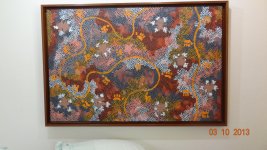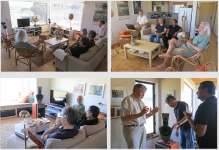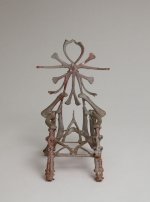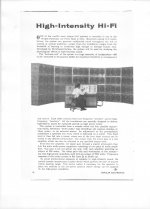Like all bipolar radiators - they need a large room as they work best far away from walls. Linkwitz also listens in the far field .. so the room interaction is again a big issue.
Thanks.
Yes, they work best far away from walls.
The omnis and the OBs to an extend work with the room.
So, non optimum placement near the walls - so many times dictated by necessity - retains the character of their sound.
George
Attachments
Does anyone collect art themselves? I found an Aboriginal artist in Australia ... Clifford Possum ... bought one of his painting for 1000 USD many years ago and had it hanging on my wall. Now his work is in the national museum in Melbourne -- bought for millions. So, I sold mine and bought a new Bangkok condo on posh Sukhumvit road. I am sure it is worth today 10 times what I sold it for because the artist has since died.
It isnt appreciated unless it is interpreted.

THx-RNMarsh
It isnt appreciated unless it is interpreted.

THx-RNMarsh
Last edited:
It isnt appreciated unless it is interpreted.
Art is very personal, folk and outsider art even more so. For instance Eugene Von Bruenchenhein's chicken and turkey bone sculptures adorn many museums as well as his extensive oeuvre of photographs of his wife ("muse") in her negligee. Little did I know that he worked in obscurity only blocks from my childhood home.
Attachments
yes, it is very personal. In the case of aboriginal painter, C.Possum (western name he took),his totem was the possum. His family was responsible for the possum... to protect it. he expressed fear of what will happen to him when he die because he could not/did not protect them from being poisoned to extinction. This painting was of a possum wandering thru the land eating certain fruits and you see the possum foot prints and tail dragging. it is the only personal meaning painting he did. When others realize this, its price will go thru the roof.
I am not even sure anyone will ever know... I learned it from the gallery owner who got the story from the artist himself. And, I have a video of the artist explaining (in broken English) the meaning and then sung a song over it sitting on the floor and then showing him signing it.
Thx - Richard
I am not even sure anyone will ever know... I learned it from the gallery owner who got the story from the artist himself. And, I have a video of the artist explaining (in broken English) the meaning and then sung a song over it sitting on the floor and then showing him signing it.
Thx - Richard
Last edited:
Thanks.
Yes, they work best far away from walls.
The omnis and the OBs to an extend work with the room.
So, non optimum placement near the walls - so many times dictated by necessity - retains the character of their sound.
George
I understand his entire process. However, it does little for reverb time of the room the location of absorption and reflections and the reflections off objects in the room, seating location in respect to room modes, etc. All these things acoustic affect sound and are variables from room to listening room.
Its less messed up than usual for far field listening, but still too much room acoustic influence and thus less than perfect accuracy to the source.
High accuracy monitors in near-field listening conditions gets the room acoustics out of the way.
I might add that with many more drivers than two (not counting subs).... it must be heard in far field for the drivers to integrate as a single point source. With the JBL 2 driver system, JBL has identified for near field use, the single listening level location by where they placed the JBL logo badge. Ear level should be at the badge level for highest accuracy.
THx-RNMarsh
Last edited:
It's a huge problem now the art brokers, gallery owners, and museums have created this inflated market for avant guard, contemporary, folk, outsider, etc. art to simply launder money with no consideration to contribution to cultural heritage.yes, it is very personal.
Actually, I do have a small single layer from a double layer paper towel partially diffusing each HF driver. They hang from the top a bit in front of all but the lower 1/4th or so of each driver, and there is a thin vertical slit in the middle running up about half-way exposing a bit more of directly radiated sound. Adjusted to taste, and doesn't sound bad. With the subs, the frequency response is decent but not tweaked perfectly flat. Percussion instruments produce tight impulses and cymbals sound pretty real. Of course, it doesn't hurt that the old Bryston 4B was recently retired and replaced with an AHB2.
EDIT: They are NS-10M to be precise. Sorry if any confusion.
Any guidelines as to what the dimensions of the slot should be? Poor me has an aluminum dome tweeter on my one (just one) speaker. Consequently it spends all it's time pointing directly away from me.
Any guidelines as to what the dimensions of the slot should be?
Sorry, no. It is purely a trial and error thing. I started without a slot and just tried to adjust vertical coverage of the cone. Didn't sound right, sounded like a bit too much upper HF blocked but lower HF okay, so a slot maybe 1/4" wide was cut to bring some or the highest stuff back. Height of the slot was adjusted for a good sounding balance.

Repetitive violation of #2 Forum’s Rule from too many of the members (not a good sign)
diyAudio Rules
Subject posts will be deleted.
Please refrain from repeating the same mistake.
Two remarks about this subject.It might be reasonable to discuss the history of time alignment of loudspeakers over the decades, and how important it is, (or not).
...
Well, what happened, and what was so good about this speaker? First, it was efficient (for a home system) at 104spl/W. This allowed virtually ideal triode amp drive that was the standard over those years. They not only could play loud, but they were 'effortless' sounding compared to direct radiators of the time, including the vaulted Acoustic Research acoustic suspension loudspeakers that were introduced in the mid-'50's.
When we talk about time alignment, we do not talk about differences between the two stereo units delays (or multiple large sources in theater's PA systems and their comb effects). Everybody knows that we need to be at equal distance of identical speakers to have an hope of some localisation of the elements in the stereo picture and good reproduction of the soundstage.
We were speaking about the time alignements of the speakers that compose our enclosures. It has a great impact on micro dynamic (correct reproduction of the impact of drums and percussions). We usually try to optimize, between two speakers, the square wave at their crossover frequency. And this has an effect too on the linearity of the response curve around this crossover frequency. High slope filters minimize the width of the bandwidth where the two speakers fight between each other, one pushing at certain frequencies while the other pulls.
The second point is a personal remark about what you called 'effortless'. I don't know exactly why (thermal effects in the moving coils, doppler effects due to large displacements of large band speakers, inertia or so ?) but, I agree and i had always thought that the A.R. "acoustic suspension" has been the most murderer to the quality of our speakers. Heavy little speaker's membranes, in ridiculously little closed boxes totally filled with absorbent materials, with a dismal efficiency, that sound completely death and lifeless. The only advantages was the price and reduced size of the speakers, that explained their success. A recession that still lasts in the history of 'hifi' psycho acoustics.
Last edited:
Actually, I find that little sealed boxes can be quite okay. Good, tight percussive punch from drums can still be felt and heard at same time with NS-10's and sealed subs, all at very reasonable SPL and not too loud. An AHB2 amplifier combined with a DAC-3 helps a great deal. I have some real drums in the same room as the speakers and I can say what comes out of the speakers can be better than real. Of course, that is also because of mix processing of percussive sounds using compressors with some degree of attack delay.
IMHO, speakers that are ported may stretch out percussive transients over time which can be seen in their waterfall plots at low frequencies.
IMHO, speakers that are ported may stretch out percussive transients over time which can be seen in their waterfall plots at low frequencies.
Last edited:
T, I meant to say, Time Alignment of the DRIVERS inside the speaker cabinet.
I have a bit of historical experience on the subject, but I don't have the space here to fully relate it properly.
In any case, alignment of loudspeaker drivers was not considered very important until about 50 years ago. That is why K-horns were so popular then. AR was also popular, mostly for the hype surrounding the speaker, and because it was more convenient for stereo reproduction, and the big corner horns were not.
TIME ALIGNMENT is actually a phrase owned by a professional speaker designer and actually involves inverting (gasp) one of the speakers to get the 'alignment' right. He lost the battle defending his copyright (or patent), because 'time alignment' is such an easy phrase to grasp.
In the early 1970's, in our Swiss lab, John Meyer and I built a 3 way all horn loaded loudspeaker with a 3 separate amp drive, time delay for the tweeter, and a 'derived', or transient perfect 3 way electronic xover in order to 'prove' that it was important. We tested it with one of the first commercial FFT systems (Tektronix) that we had in our laboratory. It DID sound significantly better than the K-horn(s) that I owned at the time back in the USA. We even switched the tweeter delay, approximately 1 foot, in and out and found that the sound was less artificial sounding with the tweeter delayed, even with the added electronic circuitry from the bucket-brigade time delay that I designed to do the job. However this design was very impractical, except for the big spenders, and I kept my K-horns for several years more. The K-horns still did 'big music' like orchestras very well, compared to most other speakers available at the time. Later, I got tired of the delays in the loudspeaker and sold them to a friend, moving toward small 2 way direct radiator speakers with a sub-woofer, in order to keep the FM distortion down, within reason.
As far as AR was concerned, I owned and daily used an AR-1, 2 way loudspeaker for about 5 years, until I got my first K-horn. Of course, the AR-1 needed a tweeter, but the AR solution burnt my ears, so I settled for a Bozak tweeter (pair) that was less extended, but easier listening.
I found the secret with the AR-1 was to reduce the damping factor of the amplifier to about 1, and then the 'overdamped or dead sound' was eliminated. I did this with a series resistor, even though it was a very inefficient way to do it. It sounded better with the resistor, than without it, unfortunately.
I have a bit of historical experience on the subject, but I don't have the space here to fully relate it properly.
In any case, alignment of loudspeaker drivers was not considered very important until about 50 years ago. That is why K-horns were so popular then. AR was also popular, mostly for the hype surrounding the speaker, and because it was more convenient for stereo reproduction, and the big corner horns were not.
TIME ALIGNMENT is actually a phrase owned by a professional speaker designer and actually involves inverting (gasp) one of the speakers to get the 'alignment' right. He lost the battle defending his copyright (or patent), because 'time alignment' is such an easy phrase to grasp.
In the early 1970's, in our Swiss lab, John Meyer and I built a 3 way all horn loaded loudspeaker with a 3 separate amp drive, time delay for the tweeter, and a 'derived', or transient perfect 3 way electronic xover in order to 'prove' that it was important. We tested it with one of the first commercial FFT systems (Tektronix) that we had in our laboratory. It DID sound significantly better than the K-horn(s) that I owned at the time back in the USA. We even switched the tweeter delay, approximately 1 foot, in and out and found that the sound was less artificial sounding with the tweeter delayed, even with the added electronic circuitry from the bucket-brigade time delay that I designed to do the job. However this design was very impractical, except for the big spenders, and I kept my K-horns for several years more. The K-horns still did 'big music' like orchestras very well, compared to most other speakers available at the time. Later, I got tired of the delays in the loudspeaker and sold them to a friend, moving toward small 2 way direct radiator speakers with a sub-woofer, in order to keep the FM distortion down, within reason.
As far as AR was concerned, I owned and daily used an AR-1, 2 way loudspeaker for about 5 years, until I got my first K-horn. Of course, the AR-1 needed a tweeter, but the AR solution burnt my ears, so I settled for a Bozak tweeter (pair) that was less extended, but easier listening.
I found the secret with the AR-1 was to reduce the damping factor of the amplifier to about 1, and then the 'overdamped or dead sound' was eliminated. I did this with a series resistor, even though it was a very inefficient way to do it. It sounded better with the resistor, than without it, unfortunately.
I found the secret with the AR-1 was to reduce the damping factor of the amplifier to about 1, and then the 'overdamped or dead sound' was eliminated. I did this with a series resistor, even though it was a very inefficient way to do it. It sounded better with the resistor, than without it, unfortunately.
I'm sure you remember that 2 pair stacked large Advent's were considered hi-end by The Absolute Sound, paper tweeters and all.
Scott, I am trying to promote tolerance from people who both think that you and I, who appreciate a time aligned speaker like the Met 7, and the K-horn, which is owned by others here are being somewhat diminished by our 'non-ideal' solutions to hi fi reproduction. I hope that I can be more dispassionate than some here about speaker quality. There is no perfect solution, and the best solutions are usually rather expensive.
Now back to my history, in 1975, I was commissioned to design a studio quality loudspeaker by a Swiss based firm, that required no electronic delays, but could use multiple amps. I went for what essentially Richard Marsh and T appear to own now, with what was available at the time.
A new company, called Emilar, appeared on the scene, and they had a radically 'shortened' horn (compared to classical solutions normally used) that looked perfect for 'Time Alignment'. So we made a large woofer cabinet and put the horn on top, moving it back and forth for best time alignment with an oscilloscope. By this time, the Swiss Lab with John Meyer had closed, along with the institute that supported it, and I had to use the fact that I lived above the city of Montreux in a 2 story house, where the upper floor had a balcony overlooking Lake Geneva and my first direct reflection would be France, so I was able to get along without an FFT machine, etc just putting my B&K mike out in space. I did a pretty credible job of aligning the speakers, and the horn was independently measured by Richard Heyser as being almost ideal, but the driver for the horn cut off abruptly at about 13KHz, so I had to add an array of super tweeters to get the frequency response right, and then the fun began! Trying to make x-overs, even electronic ones that did the job right was extremely difficult. I finally did it, but to my dismay, I didn't like the sound of my efforts, and I realized that there is more to speaker quality, than just: Time alignment, low distortion, high quality drivers, infinite baffle, and multilayer cabinet damping, so I gave up speaker design, and have left it others for the last 40 years.
Now back to my history, in 1975, I was commissioned to design a studio quality loudspeaker by a Swiss based firm, that required no electronic delays, but could use multiple amps. I went for what essentially Richard Marsh and T appear to own now, with what was available at the time.
A new company, called Emilar, appeared on the scene, and they had a radically 'shortened' horn (compared to classical solutions normally used) that looked perfect for 'Time Alignment'. So we made a large woofer cabinet and put the horn on top, moving it back and forth for best time alignment with an oscilloscope. By this time, the Swiss Lab with John Meyer had closed, along with the institute that supported it, and I had to use the fact that I lived above the city of Montreux in a 2 story house, where the upper floor had a balcony overlooking Lake Geneva and my first direct reflection would be France, so I was able to get along without an FFT machine, etc just putting my B&K mike out in space. I did a pretty credible job of aligning the speakers, and the horn was independently measured by Richard Heyser as being almost ideal, but the driver for the horn cut off abruptly at about 13KHz, so I had to add an array of super tweeters to get the frequency response right, and then the fun began! Trying to make x-overs, even electronic ones that did the job right was extremely difficult. I finally did it, but to my dismay, I didn't like the sound of my efforts, and I realized that there is more to speaker quality, than just: Time alignment, low distortion, high quality drivers, infinite baffle, and multilayer cabinet damping, so I gave up speaker design, and have left it others for the last 40 years.
Last edited:
Time alignment has probably been more a trial and error for problems with diffraction, resonate issues, and bouncing the HF from LF on the driver. Every since people stopped placing drivers too far apart for their wave lengths the issue seems to be more of a marketing device than legit one in sound based on everything I've heard. Many of the most by the book type engineers of loud speakers simply don't care at all about it...
When you do stuff like slope the baffle it has more to do with how the lobing of the power response projects than time itself. I mean, think about phase... You're trying to time align two moving targets? Maybe with a very steep crossover (active perhaps) it would help the transition from one driver to another, but I wouldn't count on it being important.
When you do stuff like slope the baffle it has more to do with how the lobing of the power response projects than time itself. I mean, think about phase... You're trying to time align two moving targets? Maybe with a very steep crossover (active perhaps) it would help the transition from one driver to another, but I wouldn't count on it being important.
- Status
- Not open for further replies.
- Home
- Member Areas
- The Lounge
- John Curl's Blowtorch preamplifier part III


